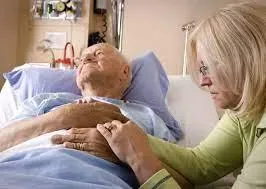

Understanding the Physical Process of Dying: A Comprehensive Guide
Understanding the Physical Process of Dying: A Comprehensive Guide
Introduction
Welcome to our comprehensive guide on the physical process of dying. At Unified Care Hospice, we believe in providing you with the most accurate and detailed information to help you understand this natural phenomenon. In this article, we will explore the intricate details of the physical process of dying, shedding light on the various stages and physiological changes that occur during this transition.
The Initial Stages: Pre-Active and Active Dying
Pre-Active Dying
Pre-active dying refers to the period leading up to the active dying process. During this stage, individuals may experience a decline in energy levels, reduced appetite, and increased sleep. It's important to note that each person's experience may vary, and not all individuals will exhibit the same symptoms.
Active Dying
As the physical process of dying progresses, individuals enter the active dying phase. This stage is characterized by more noticeable changes in the body as it prepares for the end of life. Let's delve into the key aspects of active dying:
Cardiovascular Changes
During active dying, the cardiovascular system undergoes significant transformations. The heart rate may become irregular, and blood pressure tends to fluctuate. As the body's natural processes slow down, circulation to the extremities may decrease, resulting in cold hands and feet.
Respiratory Changes
Respiratory changes are also prominent during the active dying process. Breathing patterns may become irregular, with periods of rapid or shallow breaths followed by intervals of apnea. This can be distressing for both the individual and their loved ones, but it's important to provide comfort and reassurance during this time.
Neurological Changes
Neurological changes are observed as the body prepares for the final stages of life. The person may experience decreased responsiveness and may become less aware of their surroundings. It's crucial to create a calm and peaceful environment, ensuring their comfort and well-being throughout this process.
Palliative Care and Symptom Management
As a person approaches the end of life, palliative care becomes an essential component of their overall well-being. The primary focus shifts from curative treatments to providing comfort and improving the quality of life. Here are some key aspects to consider:
Pain Management
Pain management is crucial in ensuring the comfort of individuals nearing the end of life. Various medications and therapies, such as opioid analgesics and non-pharmacological interventions, can be employed to alleviate pain and promote a sense of ease.
Symptom Control
Apart from pain, individuals may experience other distressing symptoms, including nausea, shortness of breath, and anxiety. By employing a comprehensive approach to symptom management, healthcare professionals can enhance the individual's overall comfort and minimize discomfort.
Emotional and Psychological Support
The physical process of dying can be emotionally and psychologically challenging for individuals and their loved ones. Providing compassionate support, counseling services, and facilitating open communication can help address these emotional needs, fostering a sense of peace and acceptance.
The Final Moments: Approaching Death
As an individual nears the end of their life, there are specific signs and symptoms that indicate the approach of death. It's important to be aware of these indications to ensure appropriate care and support. Some common signs include:
Decreased Consciousness
Individuals may gradually become less responsive and spend more time in a state of unconsciousness. This is a natural progression and should be met with understanding and comfort.
Changes in Breathing Patterns
Breathing patterns may become more irregular and shallow, with longer pauses between breaths. This is known as Cheyne-Stokes.
Changes in Skin Color and Temperature
As the body prepares for the final moments, there may be noticeable changes in skin color and temperature. The skin may become pale or have a bluish tinge, indicating decreased circulation. Additionally, the extremities may feel cool to the touch.
Weakening of Vital Signs
During the approach to death, vital signs such as heart rate and blood pressure may gradually weaken. It's important to monitor these signs and provide appropriate care to ensure the individual's comfort and dignity.
The Importance of Compassionate End-of-Life Care
Compassionate end-of-life care plays a vital role in supporting individuals and their families during this challenging time. It involves a holistic approach that addresses not only the physical aspects but also the emotional, psychological, and spiritual needs of the individual. Here are key components of compassionate end-of-life care:
Open Communication
Encouraging open and honest communication allows individuals to express their wishes, fears, and concerns. It also enables healthcare providers and loved ones to provide the necessary support and understanding.
Respecting Individual Choices
Respecting individual autonomy and honoring their choices regarding medical interventions, pain management, and end-of-life decisions is crucial. This includes discussions about advanced care planning, such as living wills and healthcare proxies.
Emotional Support for Families
Supporting the families and loved ones of individuals nearing the end of life is essential. Providing emotional support, grief counseling, and resources for bereavement can help them navigate this challenging period with strength and resilience.
Creating a Comforting Environment
A comfortable and peaceful environment contributes significantly to the well-being of individuals during the dying process. This includes ensuring privacy, managing noise levels, and incorporating elements of personal comfort and familiarity.
Conclusion
In conclusion, understanding the physical process of dying is essential for providing compassionate and comprehensive end-of-life care. By recognizing the stages and changes that occur during this natural transition, we can better support individuals and their families, ensuring comfort, dignity, and peace during their final moments.
Remember, each person's journey is unique, and it's crucial to approach end-of-life care with empathy, respect, and a commitment to enhancing their quality of life. Let us strive to create a society that embraces and supports individuals through every stage of their lives, including the profound process of dying.

Interested In Care For Yourself Or A Loved One? Give Us A Call Today To Learn More.
© 2022 Unified Care Hospice - All Rights Reserved
info@ucarehospice.com
702-982-8266
